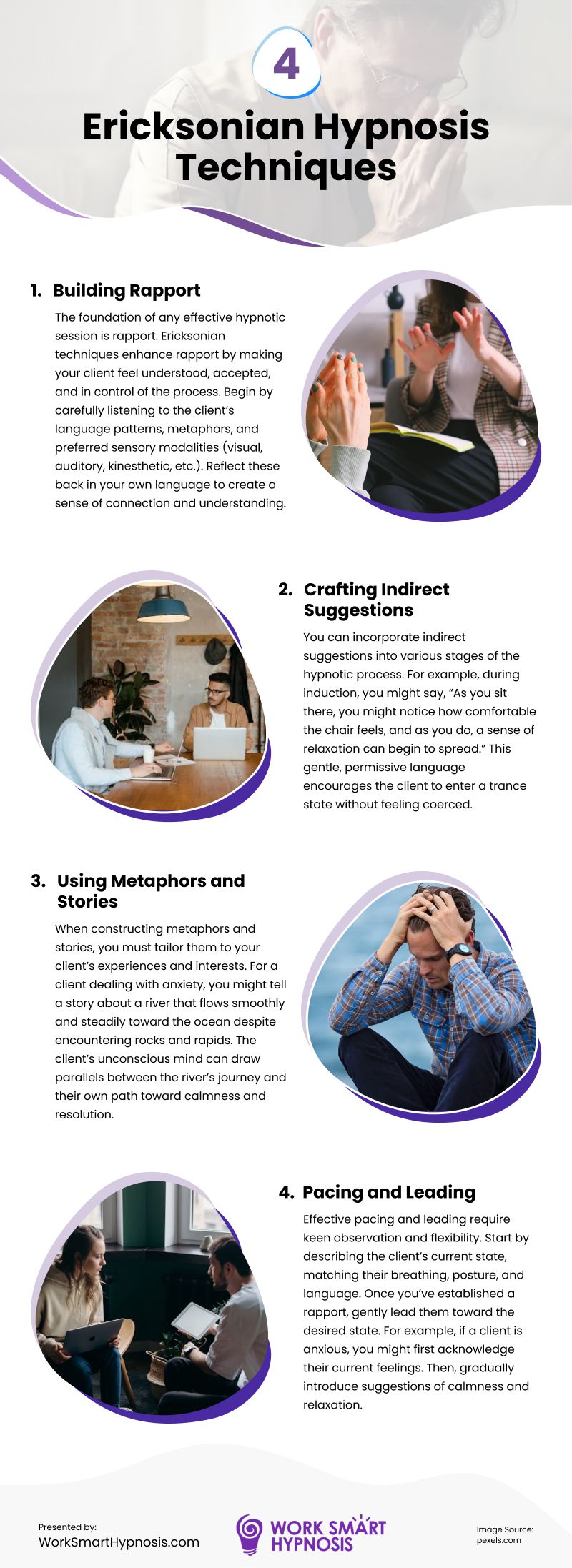Hypnosis is both an art and a science, requiring a blend of intuition, technique, and a deep understanding of human psychology. You must always strive to find ways to improve your skills and hone your craft. For professional hypnotists seeking to enhance their practice, incorporating Ericksonian language techniques can be transformative.
Named after Milton H. Erickson, a pioneering psychiatrist and hypnotherapist, Ericksonian methods emphasize indirect suggestion, storytelling, and the use of language to tap into the unconscious mind. Let’s explore Ericksonian techniques and practical insights for integrating them into your work as a professional hypnotist.
What is Ericksonian Hypnosis?
Ericksonian hypnosis diverges from traditional, directive hypnosis by using a more subtle and indirect approach. Erickson believed that each individual has the resources and solutions they need within their unconscious mind. He viewed his role as a hypnotherapist as guiding clients to find those solutions rather than presenting them with the answers. In his view, a hypnotist should facilitate access to these buried mental resources, often through indirect means.
Erickson’s techniques are characterized by their flexibility, use of the client’s own language and experiences, and utilization of metaphors and stories.
Practical Applications of Ericksonian Techniques
Building Rapport
The foundation of any effective hypnotic session is rapport. Ericksonian techniques enhance rapport by making your client feel understood, accepted, and in control of the process. Begin by carefully listening to the client’s language patterns, metaphors, and preferred sensory modalities (visual, auditory, kinesthetic, etc.). Reflect these back in your own language to create a sense of connection and understanding.
Crafting Indirect Suggestions
You can incorporate indirect suggestions into various stages of the hypnotic process. For example, during induction, you might say, “As you sit there, you might notice how comfortable the chair feels, and as you do, a sense of relaxation can begin to spread.” This gentle, permissive language encourages the client to enter a trance state without feeling coerced.
Note especially the use of the word “might.” You are not demanding that your client notice the chair or stating that they notice it when they may not. You leave room for their reality while suggesting a change if they don’t already feel the chair’s comfort.
Using Metaphors and Stories
When constructing metaphors and stories, you must tailor them to your client’s experiences and interests. For a client dealing with anxiety, you might tell a story about a river that flows smoothly and steadily toward the ocean despite encountering rocks and rapids. The client’s unconscious mind can draw parallels between the river’s journey and their own path toward calmness and resolution.
If possible, don’t directly point out the metaphor. Avoid saying, “You are like the river, and those rocks are only temporary disturbances.” That takes you from the desired indirect language to a more direct approach.
Pacing and Leading
Effective pacing and leading require keen observation and flexibility. Start by describing the client’s current state, matching their breathing, posture, and language. Once you’ve established a rapport, gently lead them toward the desired state.
For example, if a client is anxious, you might first acknowledge their current feelings. Then, gradually introduce suggestions of calmness and relaxation. Recognizing and describing what the client is currently experiencing builds rapport and trust, making subsequent suggestions more effective.
Rather than actively driving them to a goal, allow them to set the pace of the process. This technique is especially effective for hesitant clients or clients with a history of trauma, who may be more sensitive to perceived pressure or lack of control.
Integrating Ericksonian Techniques into Your Practice
Practice and Reflection
Integrating Ericksonian techniques into your sessions requires ongoing practice and reflection. Start by experimenting with these techniques in your sessions, paying close attention to the client’s responses. Reflect on what worked well and what could be improved.
Focus on what worked, what didn’t, and why you think those outcomes occurred. Was it because your metaphor may have been too direct? Perhaps you felt something connected for the client, so you tried to move on. On reflection, you may see that their pace was a bit slower. They needed time to catch up, and by not providing that, you weren’t as effective.
By reflecting on what worked–or didn’t–and why that seemed to be the case, you will refine your approach.
Continuous Learning
Ericksonian hypnosis is a rich and nuanced field. There is always more to learn. Engage with professional development opportunities, such as workshops, seminars, and courses on Ericksonian techniques. Reading books and articles by Erickson and his contemporaries can also deepen your understanding and inspire new approaches. An advanced hypnotherapy course can present you with new, innovative ways to integrate Ericksonian language and other advanced concepts into your practice.
Flexibility
Remember that what works for one client may not be effective with another. What worked during the last session with someone may not work next time. Tailor each session to the client, and be flexible enough to alter your plans as you see their responses.
If you attempt to integrate these approaches but fail to see results, consider advanced training. Additional education can deepen your understanding of Ericksonian language and how to use it in your practice effectively.
Elevating your hypnotic skills with Ericksonian language techniques can significantly enhance the effectiveness of your practice. By embracing principles such as utilization, indirect suggestion, and metaphors and stories, you can create more flexible, client-centered hypnotic experiences. As you integrate these techniques, remember to practice, reflect, and seek continuous learning and support. With dedication and mindfulness, you can harness the transformative power of Ericksonian hypnosis to help your clients achieve profound and lasting change.
Video

Infographic
Hypnosis combines art and science, relying on intuition and psychology. Always seek to improve your skills. For professional hypnotists, Ericksonian language techniques can enhance your practice. Check out the infographic for practical applications.




